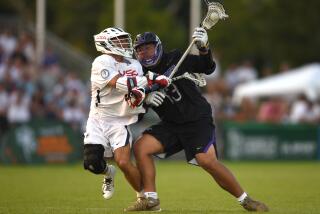Hell on Two Wheels : Quad Rugby Roughly Equivalent to Wheelchair Basketball, Players Say
- Share via
SEAL BEACH — When Keith Lawson broke his neck tackling a quarterback 12 years ago, the football player in him didn’t die with the use of his legs. He missed the clips and hits--the contact--of the gridiron.
Then Lawson, 33, of Irvine, found quad rugby, an extreme sport for the disabled that draws rules from basketball, hockey and rugby--and inspiration from a tough night at the roller derby.
“When I first tried rugby, I decided this was it,” said Lawson, who plays for the Long Beach LandSharks of the Western Quad Rugby Assn. “It’s the closest thing to playing football, the aggressive nature. It’s a contact sport.”
The game originated in Canada in the 1970s among quadriplegics as an alternative to wheelchair basketball.
Most players suffer at least partial paralysis in four limbs. Despite public perception, many have some--but not all--sensation and movement in their shoulders, arms and hands, though they are paralyzed below the waist.
“When people think of quads, they think of Christopher Reeve, but there are many quads who are active in this game,” said Lawson, who has partial movement of his arms.
The LandSharks, a team of mostly Orange County guys, use a gymnasium at the U.S. Naval Weapons Station in Seal Beach as their home court. The sharks represent Long Beach and Orange County in the Western Quad Rugby Assn., which has clubs in Los Angeles, San Diego, Oceanside, Northridge and other cities. Many will compete today, Saturday and Sunday at the season opener in San Diego.
The respectability of international play, corporate sponsorship and an invitation to the 2000 ParaOlympics in Sydney has helped lift the game above the brutal image of its original name--”murder ball.”
Wheelchair rugby rules may appear strange to the uninitiated. The goal is to carry a volleyball--a rugby ball would be too heavy to throw--across the opponent’s line for a one-point goal, while the defenders block and try for the ball. Four players from each team are on the court at once, and there are frequent rotations.
Though there are spills and other mishaps, few get hurt.
“The chairs take a worse beating than the body,” said Raymond Monzon, 35, a LandShark from Tustin. “You might get a pinched finger, but it is usually not worse than that.”
But the spirit of murder ball still lives on.
During last weekend’s match in Seal Beach against the Casa Colina Buccaneers, which represents south Orange County and North County San Diego and is the fifth-ranked team in the nation, the LandSharks proved that this sport isn’t for guppies.
Moving at high speeds in brakeless wheelchairs--they stop with their hands and by turning--the players blew tire after tire driving into each other like bumper cars, as Navy personnel, wives and friends watched from the sidelines.
“They get just as hotheaded and just as aggressive as any other activity where guys get together,” said Susan Alvarez, 32, wife of LandShark Bill Alvarez.
Equipment is built for safety. Players strap into specially designed wheelchairs with black spoke coverings and guard rails.
“Three years ago, everyone was using old chairs out of the garage or their everyday chairs,” said Ron Fredette, 41, a Buccaneer from Tustin. “This thing has totally evolved.”
The spirit is friendly, but play can get rough. There is a penalty box for those who overdo it.
“I get my adrenaline kick out of it,” said Bill Alvarez, 33, a LandShark from Costa Mesa. “I get heavily into it, like it’s the Super Bowl.”
The LandSharks hatched about eight years ago in the rehabilitation clinics of a Long Beach hospital, Monzon said. They are currently without a sponsor to pay for equipment and travel; chairs alone run $2,000 apiece.
But what the team lacks in money, it makes up in camaraderie.
“This kind of like our own sport,” Lawson said. “The paraplegics have basketball. We have this.”
More to Read
Go beyond the scoreboard
Get the latest on L.A.'s teams in the daily Sports Report newsletter.
You may occasionally receive promotional content from the Los Angeles Times.










